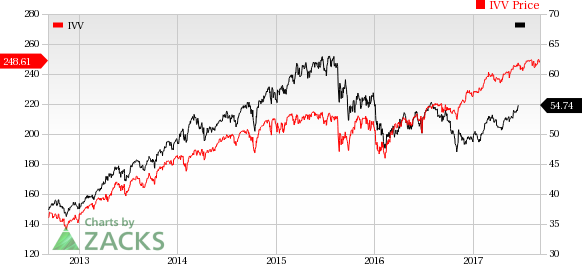Technology plays a crucial role in the evolution of various sectors, retail being prominent among them. The retail landscape has been witnessing a sea change with its focus shifting gradually from brick-and-mortar to online shopping.
Amazon.com Inc. (NASDAQ:AMZN) has been in the spotlight for the last few years, as changing customer patterns have made the retail industry fall back more on e-Commerce. The company’s technological prowess has provided it an upper hand over other retailers who are still at their nascent stage in the e-Commerce field.
Story Behind Amazon’s Success
Technology is giving shape to Amazon’s innovative business ideas. Apart from providing customers a seamless retail experience — user friendly website and mobile app as well as payment and delivery system — technology has been helping the company in saving costs and increasing transaction efficiency.
Amazon has been also testing waters with innovations. These include a drive-in-grocery delivery service AmazonFresh Pickup wherein one can order groceries online and collect them from a store nearby, and “cashier-less” stores (Amazon Go – the company’s first brick-and-mortar grocery store). It has also added online and offline features to its bookstores.
Not only this, Amazon always tries to bring in different user-friendly technological gadgets that even big tech companies haven’t thought of. The best example of this is Dash Button and Echo devices. These devices are highly coveted for their multi-utility feature.
Amazon’s cloud computing arm, Amazon Web Services (AWS) is providing the entire technological infrastructure. The company is continuously investing in enhancing its cloud infrastructure and Artificial Intelligence capabilities that are helping it to execute plans, better understand customer needs and simplify the overall retail process.
Why NVIDIA & Other Tech Stocks Are in Focus
With Amazon’s recent acquisition of Whole Foods Market (NASDAQ:WFM), the situation has worsened for retailers now. The acquisition has provided Amazon the scope to fortify its position in the brick-and-mortar space, and will enhance its distribution and fulfilment capabilities.
Amazon’s move has raised question about the survival of other grocery store operators, particularly in the United States. Grocery stores already operate under razor thin margins and will thus face extreme difficulty in coping with Amazon’s pricing strategy and the technique of bringing in customers, for which it is well known.
Looking at the successful run of Amazon, retailers have understood by now that in a changing landscape, market understanding and data information hold the key to gaining an edge over rivals. Therefore, to counter the growing threat from Amazon, various retail bellwethers are teaming up with tech companies.
The latest tech company to benefit from this trend is NVIDIA Corporation (NASDAQ:NVDA) . Recently, Wal-Mart Stores, Inc. (NYSE:WMT) announced that it will build its own cloud-based data centers by using NVIDIA chips. Wal-Mart currently uses Amazon’s AWS for its cloud needs. The move will help it to shift from the rival’s infrastructure. Also, Wal-Mart partnered with Alphabet’s (NASDAQ:GOOGL) Google last month to give shoppers the ability to order thousands of products through Google Express using voice-activated shopping.
Wal-Mart is not the only company making efforts to counter Amazon. Earlier this year, Target Corporation (NYSE:TGT) announced that it will invest $7 billion over the next three years in different areas, of which digital transformation is primary. Last month, the company also announced that it will reduce its use of AWS.
As retailers are increasingly pumping up their investments to stay afloat, tech companies stand to benefit the most. The front-runners among them will be self-checkout technology and point-of-sale software providers. The space is dominated by players like NCR Corporation (NYSE:NCR) , Honeywell International Inc. (NYSE:HON) and Diebold Nixdorf, Incorporated (NYSE:DBD) .
Salesforce.com Inc. (NYSE:CRM) will benefit the most. It should be noted that with last year’s acquisition of Demandware, the company has forayed into e-Commerce shopping solution.
Going forward, as more retailers try to shift from Amazon’s AWS, other cloud computing providers will likely prosper. In the cloud computing space, companies like Microsoft Corporation (NASDAQ:MSFT) and Alphabet’s Google may see a rise in demand for their services by retailers.
Apart from this, semiconductor companies NVIDIA, NXP Semiconductor (NASDAQ:NXPI) and ON Semiconductor (NASDAQ:ON) will also be the major beneficiaries. These semiconductor companies provide microchips that are complex tiny modules that store computer memory as well as provide logic circuitry for microprocessors.
Currently, NVIDIA sports a Zacks Rank #1 (Strong Buy) while Microsoft, Alphabet, Salesforce, NCR, Honeywell, NXP Semiconductor and ON Semiconductor carries a Zacks Rank #3 (Hold).You can see the complete list of today’s Zacks #1 Rank stocks here.
More Stock News: This Is Bigger than the iPhone!
It could become the mother of all technological revolutions. Apple (NASDAQ:AAPL) sold a mere 1 billion iPhones in 10 years but a new breakthrough is expected to generate more than 27 billion devices in just 3 years, creating a $1.7 trillion market.
Zacks has just released a Special Report that spotlights this fast-emerging phenomenon and 6 tickers for taking advantage of it. If you don't buy now, you may kick yourself in 2020.
Click here for the 6 trades >>
NCR Corporation (NCR): Free Stock Analysis Report
Diebold, Incorporated (DBD): Free Stock Analysis Report
Amazon.com, Inc. (AMZN): Free Stock Analysis Report
Alphabet Inc. (GOOGL): Free Stock Analysis Report
Microsoft Corporation (MSFT): Free Stock Analysis Report
Salesforce.com Inc (CRM): Free Stock Analysis Report
Wal-Mart Stores, Inc. (WMT): Free Stock Analysis Report
Target Corporation (TGT): Free Stock Analysis Report
NVIDIA Corporation (NVDA): Free Stock Analysis Report
NXP Semiconductors N.V. (NXPI): Free Stock Analysis Report
ON Semiconductor Corporation (ON): Free Stock Analysis Report
Original post

